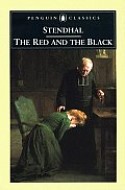Penguin Classics cover: from which painting?
I started reading The Red and the Black by Stendhal. Chapter 7 is entitled Les affinités électives, possibly a reference to Elective Affinities, published by Goethe 21 years earlier. This passage perfectly illustrates life imitating art:
“À Paris, la position de Julien envers Mme de Rênal eût été bien vite simplifiée ; mais à Paris, l’amour est fils des romans. Le jeune précepteur et sa timide maîtresse auraient retrouvé dans trois ou quatre romans et jusque dans les couplets du Gymnase, l’éclaircissement de leur position. Les romans leur auraient tracé le rôle à jouer, montré le modèle à imiter ; et ce modèle, tôt ou tard, et quoique sans nul plaisir, et peut-être en rechignant, la vanité eût forcé Julien à le suivre.”[1]
“In Paris, Julien’s position with regard to Madame de Renal would very soon have been simplified; but in Paris love is the child of the novels. The young tutor and his timid mistress would have found in three or four novels, and even in the lyrics of the Gymnase*, a clear statement of their situation. The novels would have outlined for them the part to be played, shown them the model to copy; and this model, sooner or later, albeit without the slightest pleasure, and perhaps with reluctance, vanity would have compelled Julien to follow.” –translation by C. K. Scott-Moncrieff (1889–1930)
The first literary example of life imitating art was Don Quixote in which Alonso Quixano has been driven crazy by reading too many mediaeval knight-errantry romances such Amadis of Gaul, the pulp fiction of the day.
The Red and the Black is an exceedingly accomplished novel.
*My excellent Dutch translation by Hans van Pinxteren (Pandora Pockets, Uitgeverij Contact, p.45) translates Gymnase as cabaret (liedjes in het cabaret). Gymnase probably refers to the Théâtre du Gymnase Marie Bell, rather than a gymnasium.


Le Rouge et le Noir is one of my all time favorites, but my French is too poor to allow me to read anything but small passages in the original at one time.
S is being ironic, as usual, about how in Paris life imitates art, leaving love the poorer for it – something to be expected when the artistic model is mere novels, i.e., junk chick-lit 19th century style. Julien Sorel, one of the most amazing (anti?) heroes of literature, is, of course, incapable of playing the part laid out for him, or is he? Doesn’t he try and live out the literary-historical cliche of the Napoleon wannabee?
If you haven’t read it, I’m sure you are in for a treat when he gets to Paris…I don’t want to spoil it.
BTW, I think Don Q goes one better than the life-imitating-art theme. There is a passage in the middle when Don Q goes to a book store and starts to upbraid the owner for carrying novels that feature adventures, supposedly his writtten by him as a memoir, i.e., the ones the reader has just finished in the first part!
Post-Modern WAY before Modern even got going!
Don Q goes to a book store and starts to upbraid the owner for carrying novels that feature adventures, supposedly his writtten by him as a memoir, i.e., the ones the reader has just finished in the first part!
Yes Don Q is the first modern novel, the first psychological novel, the first piece of metafiction and the first postmodernist novel. Amazing huh?
J
Pingback: Is self-loathing the key to understanding Julien Sorel? « Jahsonic